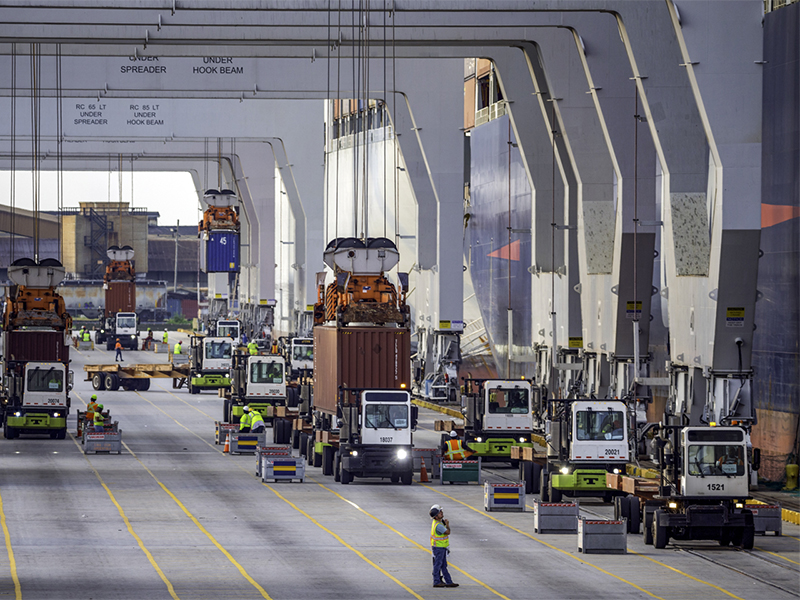Whether it’s because of COVID cancellations, labor shortages or increased demand, America’s supply chain system is choking.
As we approach the busiest shopping season of the year, containers are piling up at the nation’s ports, and many consumers worry their gift purchases will be backlogged or unavailable.
We’re witnessing a perfect storm of disruptions to the very complex, but generally reliable, system that connects manufacturers to customers, said supply chain expert Marty Parker — a lecturer in the University of Georgia’s Terry College of Business department of management. Parker said logistics experts are learning valuable lessons about how to strengthen the system in the future.
When the media calls this a supply chain crisis, what does that mean?
Simply, we are not getting the things we want or need when we want or need them.
For example, a lot of people want to buy new cars. But because of the pandemic there was a substantial reduction in purchases of the computer chips used in cars. Car companies expected the pandemic recession to continue, but the economy just came roaring back after everything opened. Suddenly car companies couldn’t get the chips and other parts they needed for cars.
Similarly, companies can’t get new trucks. That’s a crisis because trucks deliver our food, they deliver our packages, they deliver the fuel we need for our power plants.
How did we get here?
We got here for a lot of reasons. First and foremost, we’re still in the midst of a pandemic that has sickened or killed a lot of people. If people get sick in China in a manufacturing area, suddenly they can’t make the products we need. Or if there’s an outbreak in a shipping port or a distribution center, you can’t ship from there.
The other thing about the pandemic is that it’s taken 6-7 million people out of the workforce. You have [older workers] who don’t want to put themselves at risk, so they retired several years early. Men and women who couldn’t get child care had to stay home with their children. When you don’t have enough labor, you don’t have enough people to unload the shipping containers. You don’t have enough labor in terms of truck drivers to deliver goods. You don’t have enough people to store and distribute goods.
The pandemic was the big factor. The second thing is that there was a large change in the demand curves. Many of us went from eating out in restaurants pre-COVID to cooking at home, so the amount of demand on grocery stores went way up, and the amount of demand on restaurant suppliers went way down. That’s starting to change now but we don’t know what’s going to happen next.
Logistics and supply chain operations are more than a $60 billion industry in Georgia. How is the current crisis affecting Georgia’s Port of Savannah and distribution centers?
It’s making all of America’s ports think about how they can run faster and increase their capacity. I just saw on the news that the Long Beach Port is moving to 24-hour operation to increase its capacity. They’re running out of capacity at the port, but truck drivers are in short supply and trucks themselves are in short supply.
We have a lot of distribution centers in Georgia and as soon as they get materials in from the port, they’re already shipping all those products out to meet back orders.
Is the Port of Savannah, the fourth busiest in the nation, in better shape than other ports? Are West Coast ports seeing more cargo?
Companies are using whatever port they can right now. I don’t think Savannah’s situation is better or worse, I think that they’re all in the same boat. In the past, companies would ship to the lowest cost port, but now they’re just trying to get docked and offloaded.
Is there something consumers or companies should do to prevent this in the future or is it just one of those perfect storm things?
I’ve read that the data at our ports isn’t very available. One of the longer-term fixes would be to get all the data from ports available. That’s one big thing that would help a lot. If you knew where everything was in real time along the entire supply chain — from manufacturing to customer delivery — that would help substantially.
The second thing is that we probably don’t need as many versions of things. The best example is toilet paper. There’s every kind of toilet paper you can imagine— soft, strong, single roll, double roll, triple roll. Do we really need all those different kinds? The answer is no. And having that variety makes the availability of all the toilet paper worse because to make more the manufacturing and packaging equipment has to be changed over and set up again.
For the first time in my career, I’m hearing about products being discontinued. It’s great to have multiple products and choices if a company can truly differentiate a product and if there’s a good reason why the consumer needs it, but I don’t think that’s the case with something like toilet paper.
Will this crisis affect Thanksgiving dinners?
The only way I could see it affecting Thanksgiving dinners is in the case of individual shortages, and those would be more connected to weather effects. I have seen a shortage of pumpkins, but that had more to do with weather than it had to do with supply chain.
Should we hurry up and buy our holiday gifts now?
Yes, absolutely. This is a good idea anyway because the popular gifts disappear early. This year with the backlog of shipments, you should buy early if you can.

